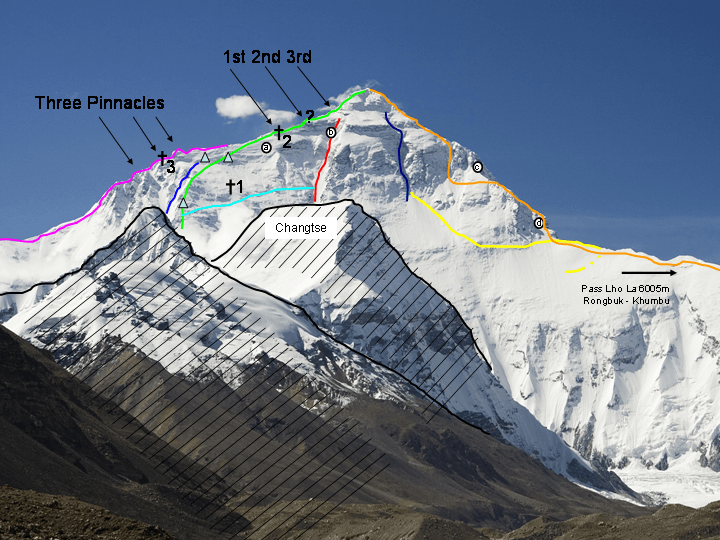Three Steps

The Three Steps are three prominent rocky steps on the northeast ridge of Mount Everest. They are located at altitudes of 8,564 metres (28,097 ft), 8,610 metres (28,250 ft), and 8,710 metres (28,580 ft). The Second Step is especially significant both historically and in mountaineering terms. Any climber who wants to climb on the normal route from the north of the summit must negotiate these three stages.
The First Step consists of large boulders that pose a serious obstacle, even for experienced climbers, because of their height above sea level. Many mountaineers have met their end on the First Step, among them "Green Boots", a corpse wearing neon green climbing boots and a red coat, which served as a somber landmark for climbers to gauge their distance to the top, which has now possibly identified as Tsewang Paljor.[1] His fellow climbers who also perished on that particular day in 1996 are Tsewang Smanla and Dorje Morup.[1] There are also other climbers that have died under that rock, namely David Sharp and Francys Arsentiev.
The Second Step is the best known of the rocky steps. The steep section, at an altitude of 8,610 m, has a climbing height of forty metres, of which the last five are almost vertical. The step was climbed for the first time in 1960 by Wang Fuzhou, Gongbu, and Qu Yinhua while their teammate Liu Lianman volunteered to be a human ladder. The climbing difficulty of this spot was reduced in 1975 when a Chinese team affixed a ladder to the step that has been used since then by almost all climbers.
The Third Step is easier to climb. Its climbing height is about 10 metres, after which the summit snowfield is reached.
Important climbs of the Second Step
The 1921 British Mount Everest reconnaissance expedition was the first to attempt to climb Mount Everest. It was followed by further British expeditions in 1922, 1924 and 1933. They had to make the ascent from the north, since Nepal was closed. The situation became reversed after the Chinese invasion of Tibet. Expeditions launched after that had to use the southern approach through Nepal (see Shipton, Eric: The Mount Everest Reconnaissance Expedition 1951). The technical difficulties, especially in climbing the Second Step, were still unknown. There is ongoing discussion – even today – as to whether the Second Step was ever surmounted by George Mallory and Andrew Irvine in 1924. It was surmounted in 1960 as part of the first ascent of Mount Everest via the north route. Here, a shoulder stand was used to climb the last five metres.
The step was first climbed unaided in 1985 by the Spaniard Oscar Cadiach. He assessed the final rock face as 5.7 to 5.8 (V+ in UIAA classification). Theo Fritsche, an Austrian, climbed the step in 2001 free solo on-sight and came to a similar conclusion. Conrad Anker climbed the Second Step in 1999 and assessed the level of difficulty as 5.10. On this ascent Anker supported himself using the Chinese ladder. In 2007, Anker repeated the climb with Leo Houlding; this time, however, he first removed the ladder in order to climb the step unaided.
Sources
- Mantovani, Roberto and Diemberger, Kurt (1997). Mount Everest – Kampf in eisigen Höhen. Moewig. ISBN 3-8118-1715-9
- Hemmleb, Jochen (2009). Tatort Mount Everest: Der Fall Mallory – Neue Fakten und Hintergründe. Herbig, Munich. ISBN 978-3-7243-1022-8.
References
- 1 2 Nuwer, Rachel (October 2015). "The tragic tale of Mt Everest's most famous dead body". BBC. Retrieved 12 March 2016.
External links
- Photograph of the Second Step including ladder and fixed ropes
- AFFIMER - Jochen Hemmleb: Conrad Anker's Near-free Ascent of the Second Step
- Photograph of second step with mountaineers
- Painting of the complete second step including ladder and ropes
- BBC - Future - The tragic tale of Mt Everest's most famous dead body - Story by Rachel Nuwer
